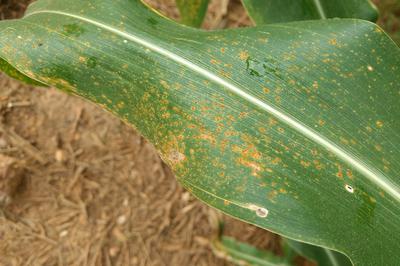Southern Rust of Maize
Puccinia polysora
Fungus
In a Nutshell
- Small, reddish-orange, powdery, densely clustered pustules on upper leaf side.
- Yellow and brown patches also appear on leaves.
- Stalk rot, lodging, poor grain quality.
Can also be found in
Symptoms
Southern Rust appears as small, reddish-orange pinhead-like pustules on the upper side of older leaves, only sparsely on the underside. These pustules are powdery, circular to oval in shape, raised and densely clustered. At later stages of the disease, they are densely distributed and might also show on younger leaves, leaf sheaths, husks and stalks. Patches of chlorosis (yellowish) and necrosis (brownish) are also present on leaves. Young leaves are more susceptible than older leaves and this makes late-planted fields more prone to the disease. Poor plant health leads to stalk rot and lodging and to poor grain quality. Its spreading potential can cause considerable yield losses.
Recommendations

Organic Control
Apply a watery extract of guaco (Mikania glomerata) to inhibit spore germination. The extract can be made by immersing whole leaves of guaco in distilled water and keeping the solution in the refrigerator for 24 hours. Afterwards, filter the extract with filter paper, dilute it in water until it reaches a concentration of 5% and apply it onto the leaves.

Chemical Control
It is important to consider a integrated approach with preventive measures together with possible biological treatments. The application of fungicides cannot heal the infected parts, so it can only be applied preventively to avoid the spreading on and between healthy plants. It is also important to apply them in a timely manner, taking into account the plant age, the incidence of the disease and weather conditions. Fungicides based on mancozeb, cyproconazole, flutriafol + fluoxastrobin, pyraclostrobin, pyraclostrobin + metconazole, azoxystrobin + propiconazole, trifloxystrobin + prothioconzole can effectively reduce the impact of the disease. One example of treatment could be : Spraying mancozeb @ 2.5 g/l as soon as pustules appear and repeat at 10 days interval till flowering.
What caused it?
Southern rust is a disease caused by the fungus Puccinia polysora, usually at later stages of plant growth in tropical to sub-tropic areas. It is an obligate parasite, which means that it can only survive on living plant material, not in soil debris or seeds. Consequently, an infection during one season does not necessarily increase the odds of getting another in the next one. Wind-blown spores from other fields or areas are the primary source of infection. It then spreads from plant to plant carried by wind and water. The optimal conditions for a heavy infection are temperatures between 27°C and 33°C and high humidity. Early infections in the vegetation period may lead to rapid and significant plant damage.
Preventive Measures
- Use resistant or tolerant varieties locally available.
- Avoid planting maize late in the season.
- Monitor the field for any sign of the disease.
- Ensure balanced fertilization to strengthen the crops.
- Avoid over-irrigation of fields during later growth stages.



